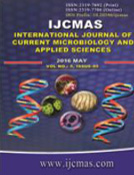


 National Academy of Agricultural Sciences (NAAS)
National Academy of Agricultural Sciences (NAAS)

|
PRINT ISSN : 2319-7692
Online ISSN : 2319-7706 Issues : 12 per year Publisher : Excellent Publishers Email : editorijcmas@gmail.com / submit@ijcmas.com Editor-in-chief: Dr.M.Prakash Index Copernicus ICV 2018: 95.39 NAAS RATING 2020: 5.38 |
Infections caused by extended spectrum β-lactamases (ESBL) producing gram negative bacteria complicate therapy and limit treatment options. The aim of the present study was to determine the prevalence and susceptibility of ESBL Escherichia coli (E. coli) and Klebsiella pneumoniae from various clinical isolates among hospitalized and outdoor patients at our tertiary care hospital. A total of 412 isolates from various clinical samples were screened for ESBL as per CLSI guidelines and confirmed by Phenotypic Confirmatory Disc Diffusion Test (PCDDT) and Double Disc Synergy Test (DDST). Antimicrobial susceptibility of these isolates was performed by Kirby- Bauer disc diffusion method. ESBL production was seen in 174/281(61.92%) of E. coli and 74/131(56.48%) of Klebsiella pneumoniae isolates. PCDDT detected 174(61.3 %) and 74(56.5%) of ESBL while DDST detected 164 (58.4%) and 70 (53.4%) of ESBL E. coli and Klebsiella pneumoniae respectively. ESBL producers were higher among inpatients 199/323(61.60%) compared to outpatients 49/89(55.05%). ESBL production was found to be highest among blood isolates. A high level of resistance was seen with third generation cephalosporins, piperacillin and cefepime in both ESBL E. coli and Klebsiella pneumoniae isolates. Strict adherence to the hospital antibiotic policy and good infection control practices would go a long way in curtailing the menace of drug resistance.
 |
 |
 |
 |
 |